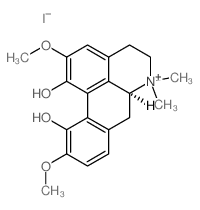6681-18-1
| Name | Magnoflorine chloride |
|---|---|
| Synonyms |
Corytuberine methochloride
Magnoflorine chloride 1,11-dihydroxy-10-methoxynaphthacene-5,12-dione (6aS)-1,11-Dihydroxy-2,10-dimethoxy-6,6-dimethyl-5,6,6a,7-tetrahydro-4H-dibenzo[de,g]quinolinium chloride 4H-Dibenzo[de,g]quinolinium, 5,6,6a,7-tetrahydro-1,11-dihydroxy-2,10-dimethoxy-6,6-dimethyl-, chloride, (6aS)- (1:1) 5,12-Naphthacenedione,1,11-dihydroxy-10-methoxy Thalictrine chloride |
| Description | Magnoflorine chloride (Magnoflorine chloride), an aporphine alkaloid found in Acoruscalamus, reduces the formation of C. albicans biofilm[1]. Magnoflorine chloride has anti-fungal, anti-antidiabetic and anti-oxidative activity[2]. |
|---|---|
| Related Catalog | |
| References |
| Molecular Formula | C20H24ClNO4 |
|---|---|
| Molecular Weight | 377.862 |
| Exact Mass | 377.139374 |
| PSA | 58.92000 |
| Storage condition | 2-8°C |
CHEMICAL IDENTIFICATION
HEALTH HAZARD DATAACUTE TOXICITY DATA
|
| Precursor 0 | |
|---|---|
| DownStream 1 | |



